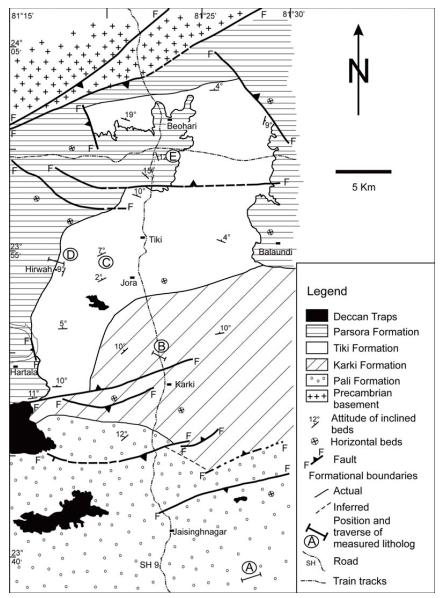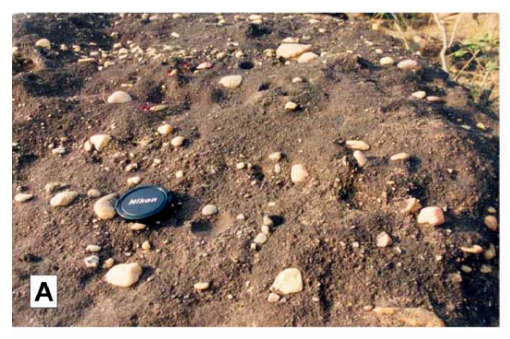Pali Fm
Type Locality and Naming
South Rewa Basin: Rocks occurring SSW near the village Pali, Bara Daigaon, Karkati are known as “Pali Beds” (Hughes, 1881) or “Daigaon Stage” (Lele, 1964). Sastry et al. (1977) placed Tiki and Pali beds together in Pali Formation. Kundu et al. (1993) separated the two units based on their lithological and faunal distinctiveness. Type section of the Pali Formation is at Pali-Birsinghpur (Mukherjee et al., 2012). [Original Publication: Hughes, T.W.H., 1881. Notes on the South Rewa Gondwana Basin. Records of Geological Survey of lndia 14, 126 -138; Lele, K.M., 1964. The problem of Middle Gondwana of India. Proceedings of the 22tld International Geological Congress, New Delhi, Session IX Gondwana, New Delhi: 181-202; Sastry, M.V.A., Acharyya, S.K., Shah, S.C., Satsangi, P.P., Ghosh, S.C., Raha, P.K., Singh, G., Ghosh, R.N. 1977. Stratigraphic lexicon of Gondwana formations of India. Geol. Surv. India, Misc. Publ. 36: 1-170; Kundu, A., Pillai, A., Thanavelu, C. 1993. Elucidation of the stratigraphic interrelationship of Pali, Tiki and Parsora formations of South Rewa Basin. Gondwana Geological Magazine Special Publication, Birbal Sahni Centenary National Symposium on Gondwana of India, Nagpur, 49-55.]
[Figure 1: Geological map Pali-Birsinghpur area showing the location measured lithostratigraphic section (A) (after Mukherjee et al., 2012)]
Synonyms: Daigaon Stage (Lele, 1964).
Lithology and Thickness
Sandstone. The Pali Formation is characterized by pebbly to coarse-grained micaceous sandstones, medium- to fine-grained sandstones, and red and green colored mudstones. Irregular to angular mud clasts are present along the fore-sets of the cross-strata within the sand bodies (see field photograph below). Apart from mud clasts, subangular to subrounded grains of quartz, chert, feldspar, mudstone, and petrified wood fragments are common. The sandstone commonly exhibits large trough and planar cross-beddings and convolution bedding. The mudstones are 4-5 m thick, red to grayish brown, and very dark red-colored with subordinate amount of brown, olive and yellowish-grey mudstone with incipient development of paleosol. At places, carbonaceous clay, abundant iron and calcareous concretions, rhizocretions and petrified wood fragments are also found. Thickness of this formation is about 1000 m (Mukherjee et al., 2012).
[Figure 2: Field photograph of pebbly to coarse-grained sandstone of the Pali Formation outcropping in Pali-Birsinghpur area (Mukherjee et al., 2012)]
[Figure 3: Measured litholog of the Pali Formation along the traverse A in the geological map (after Mukherjee et al., 2012)]
Relationships and Distribution
Lower contact
Upper contact
The Pali Formation has gradational and conformable contact with the overlying Karki Fm (Mukherjee et al. (2012).
Regional extent
South Rewa Basin: Johilla river, Son river, Beohari hills, Neosi, Bara Daigaon, Salaia, Ganjra Nala, Son–Chundi River. The Lower, Middle and Upper Pali members are equated with Barren Measures Fm, Raniganj Fm and Panchet Fm of the Damodar Basin, respectively (source Pillai et al., 2018).
GeoJSON
Fossils
Flora dopcumented from the Pali Formation comprises, Neomariopteris hughesii, Glossopteris bosei , G. communis, G. gondwanensis, G. indica, G. intermedia, G. intermittens, G. leptoneura, G. longicaulis, G. searsoliensis, G. spathulata, G. stricta, G. subtilis, G. tenuifolia, G. tenuinervis, G. vulgaris, Vertebraria indica, Utkaliolepis indica , Cordaicarpus zeilleri, Rotundocarpus striatus, Samaropsis goraiensis, S. feistmantelii, palynoassemblage: Striatopodocarpites, Faunipollenites, Striatites,Verticipollenites, Densipollenites, Lahirites, Crescentipollenites, Distriatites, Arcuatipollenites, Scheuringipollenites, Decussatisporites, Guttulapollenites, Alisporites and Weylandites (Tiwari and Awatar, 1986; Awatar, 1987, 1996, 1997, 2003, 2011; Pillai et al., 2018).
Age
Depositional setting
The Pali Formation was deposited by braided river systems as attested by the amalgamated nature of the multistoried multilateral sand bodies, high stacking density, and coarse-grained nature of the sediments. The presence of intermittent fine clastics in the Pali Formation suggests fluctuation in energy condition (Mukherjee et al., 2012).
Additional Information
References
Awatar, R., 1987. Palynological dating of Supra-Barakar formations in Son Valley Graben. Palaeobotanist, 36, 133−137. Awatar, R., 1996. Palynozonation of Middle Pali Member in Sohagpur Coalfield, Madhya Pradesh. Palaeobotanist, 43, 96−101. Awata, R., 1997. Palynological evidence for the Permian−Triassic boundary in Sohagpur Coalfield, India. Palaeobotanist, 46, 101−106. Awatar, R., 2003. A Triassic palynoflora from Pali Formation, South Rewa Gondwana Basin, Madhya Pradesh, India. Palaeobotanist, 52, 49−54. Awatar, R., 2011. Dominance of spore tetrads in the Triassic sediments of Indian Gondwana and their climatic inference. Palaeobotanist, 60, 363−368. Hughes, T.W.H., 1881. Notes on the South Rewa Gondwana Basin. Records of Geological Survey of lndia 14, 126 -138. Kundu, A., Pillai, A., Thanavelu, C. 1993. Elucidation of the stratigraphic interrelationship of Pali, Tiki and Parsora formations of South Rewa Basin. Gondwana Geological Magazine Special Publication, Birbal Sahni Centenary National Symposium on Gondwana of India, Nagpur, 49-55. Lele, K.M., 1964. The problem of Middle Gondwana of India. Proceedings of the 22tld International Geological Congress, New Delhi, Session IX Gondwana, New Delhi: 181-202. Mukherjee, D., Ray, S., Chandra, S., Pal, S., Bandyopadhyay, S., 2012. Upper Gondwana Succession of the Rewa Basin, India: Understanding the Interrelationship of Lithologic and Stratigraphic Variables. Journal Geological Society of India, 79, 563-575 Peter, J. 2009 Pillai, S.S.K., Agnihotri, D., Gautam, S., Tewari, R., 2018. Glossopteris flora from the Pali Formation, Johilla Coalfield, South Rewa Gondwana Basin, Madhya Pradesh, India: palynological evidence for a Late Permian age. Journal of the Palaeontological Society of India, 63(1), 53-72. Raja Rao, C.S. 1983. Coalfields of India Vol-III, Coal resources of Madhya Pradesh and Jammu and Kashmir. Bull. Geol. Surv. India, 45, 204. Sastry, M.V.A., Acharyya, S.K., Shah, S.C., Satsangi, P.P., Ghosh, S.C., Raha, P.K., Singh, G., Ghosh, R.N., 1977. Stratigraphic lexicon of Gondwana formations of India. Geol. Surv. India, Misc. Publ. 36, 1-170. Tiwari, R. S. and Ram-Awatar 1986. Late Permian palynofossils from the Pali Formation, South Rewa Gondwana Basin, Madhya Pradesh, 250−255. In: Proceedings 11th Indian Colloquium on Micropaleontology and Stratigraphy, Calcutta 1984, Pt.2, Stratigraphy and Microflora (Ed. Samanta, B. K.), Geological Mineral and Metallurgical Society of India.

